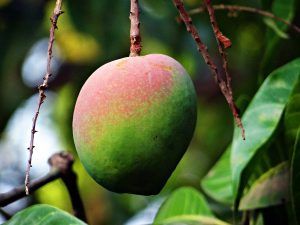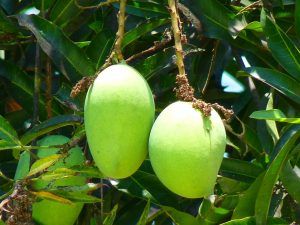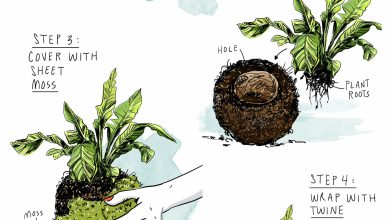Mango Care: [Soil, Humidity, Pruning and Problems]

What characteristics does the mango tree have?

The mango is a large fruit tree that can reach up to 30 meters in height and that produces one of the most appetizing fruits in nature not only for its flavor but also for its vitamin properties.
Its scientific name is Mangifera Indica of the Anacardiaceae family, it has thick branches and alternate leaves that are glossy dark green above and yellowish green below.
It is a very common tree in Latin American countries, such as Mexico (the world’s largest exporter), Brazil, Ecuador, Costa Rica, Cuba, Paraguay and Venezuela.
But it actually comes from India, where it is the national fruit, like in Pakistan. In Spain it is grown in Granada and Malaga.
It is a tree that has a main root and superficial food roots, being easy to plant in the garden where we must give it plenty of space because it requires it for its abundant nutritional production, since its branches spread out far to the sides, making it a leafy tree of wide shade.
The mango fruit is green with reddish tones, yellow when ripe, of a good size, fleshy pulp and a very sweet flavor. highly nutritious because it is a source of vitamin A, B and C, it contains iron, phosphorus, potassium, sodium and calcium, and serves as a laxative, antioxidant and anti-inflammatory.
Ripe mangoes can be eaten directly from the bush, peeling them, or in jellies, fruit salads, cakes, jams, as a seasoning for meat and fish, and even in salads, or drink in exquisitely flavored juices.
Even the green mango with salt, more acidic, is a desired food in many regions of the world, especially in tropical climates, and in India it is used to make the traditional dish known as chutney.
What soil needs does the mango have?
 The mango is not a tree that is demanding in terms of soil, because it can easily reproduce anywhere, even in low-fertility land.
The mango is not a tree that is demanding in terms of soil, because it can easily reproduce anywhere, even in low-fertility land.
That is why we find it in the least expected place, unfolding its load of delicious fruits with a sweet flavor.
Although it is not particularly demanding on the ground, the mango does need it to be deep and with good drainage because it is a plant with a lot of irrigation, about 20 liters of water a week, and if the water stagnates, its roots can rot, putting it in serious danger.
It is a tropical tree that does not support strong winds or winter frosts.
How to make the mango grow strong and vigorous?
It requires a series of conditions for its healthy development, one of them water, which, as we indicated, must be very abundant, and if we plant it before the arrival of the rains, well, better.
The best time to plant is spring, but that depends on the variety of mango that we are going to grow. What it does need is heat and sunlight (8 hours) to develop, and as has been said, keep it away from the cold, since we must avoid temperatures below 30ºC.
There is a variety of this plant that is small and can be grown in a pot from the seed that we will germinate in the ground, washing it and drying it in the sun for several days.

Once this is done, we open it with a knife, we remove the shell and in a temporary container we will implant the embryo in fertile soil; We water and place the small pot in the sunlight, and at night we will put it inside the house to prevent the cold from damaging it.
It will root in three weeks and then we will put it outside in the shade until the leaves grow and turn green, which is when we can move it to a larger pot.
Another modality can be to germinate it without soil, placing the seed in a container of water with the lower part under the water and the upper part above, in the air, where the oxygen and heat will make it grow up to 20 cm, when we can pass it to a pot that must have good drainage, so we must place stones at the bottom to facilitate it.
What humidity do mangoes need?
One of the characteristics of this plant is that, contrary to other species, it needs heat and humidity; that is, warmth and humidity in summer, and cold and dryness in winter. But they do not tolerate frost and much less snowfall, so they prefer short winters.
As it needs a lot of water and there is a possibility that we make a mistake in the watering, it is advisable to put a mulch padding around it to maintain humidity.

Likewise, fertilization must be done twice a year, in summer and in winter, which is when it is required to be able to develop strongly.
The ideal temperature for the fruit is 15-25ºC and the optimum relative humidity is 90-95%. When it is green, it should be kept at room temperature and when it is ripe, it is convenient to consume it in a reasonable time because it will tend to rot. It can also be kept in the refrigerator if we want to consume it cold.
Is it necessary to prune the mango?
We will carry out the pruning to increase the production of the fruit; also to facilitate harvesting, give order to the growth and development of the plant, improve aeration and favor the entry of light.
How often should we prune the mango?
 When the tree is young, pruning must be done during the first two years, to give it shape.
When the tree is young, pruning must be done during the first two years, to give it shape.
When the mangoes are ripe, pruning will be annual to maintain the structure and clean the inside of the tree in order to favor the entry of light and air.
The best time to prune is spring, when there is no risk of frost, to avoid loss of sap, but pruning can be done in autumn if it is not too cold.
On the other hand, when the mango is green, the best time to prune is in the heat of summer. In all cases we will use the pruning tools, that is, two-handed scissors, saw, chainsaw, height pruner and ladder.
How can we avoid mango pests and diseases?
One of the pests that most attacks the mango is the white cochineal, which we will combat with pruning and natural fungicides.

The most common disease is anthracnose, which we will attack by cleaning up the plant, eliminating wild weeds, improving the soil, avoiding waterlogging and applying foliar fungicide sprays.

Maybe you are also interested in:

![Photo of Drip Irrigation: [Concept, Types, Operation and Advantages]](https://www.complete-gardening.com/wp-content/uploads/2022/08/drip-irrigation-concept-types-operation-and-advantages-390x220.png)
![Photo of Runner Thistle: [Cultivation, Irrigation, Care, Pests and Diseases]](https://www.complete-gardening.com/wp-content/uploads/2022/08/runner-thistle-cultivation-irrigation-care-pests-and-diseases-390x220.jpg)

![Photo of Weevil: [Characteristics, Detection, Effects and Treatment]](https://www.complete-gardening.com/wp-content/uploads/2021/06/Que-es-el-picudo-390x220.jpg)